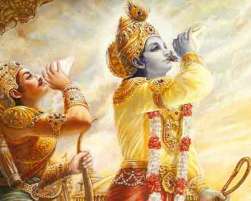 In his Tamil work Gitartha Sangraha, which is analogous to Alavandar’s Sanskrit work by the same name, Vedanta Desika briefly sums up the essence of the Bhagavad Gita. The work is in 21 verses. The Gita has 18 chapters and of these, the first six are about karma yoga and jnana yoga. Chapters seven to twelve talk about bhakti yoga. Chapters 13, 14 and 15 talk of the Supreme One, who is to be sought. The last three chapters talk about dharma.
In his Tamil work Gitartha Sangraha, which is analogous to Alavandar’s Sanskrit work by the same name, Vedanta Desika briefly sums up the essence of the Bhagavad Gita. The work is in 21 verses. The Gita has 18 chapters and of these, the first six are about karma yoga and jnana yoga. Chapters seven to twelve talk about bhakti yoga. Chapters 13, 14 and 15 talk of the Supreme One, who is to be sought. The last three chapters talk about dharma.
There are four Purusharthas, or goals for mankind — artha, kama, dharma and moksha. Artha (material wealth) and kama (desires) are sought in accordance with the principles of dharma (right conduct), with the ultimate aim being moksha (liberation from the samsaric cycle). But in the Gita, Lord Krishna talks of moksha and dharma, but not of artha and kama, elaborated M.K. Srinivasan, in a discourse.
Vedanta Desika begins by talking of karma yoga and then jnana yoga. Bhakti follows next. As one does one’s duties in the right spirit of detachment, jnana results. The next stage is immense love for the Lord and that is what guarantees liberation. But if we are to love the Supreme One, we need to know who that One is. In the very first verse, Desika says that this Supreme One is Lord Narayana who appears with His Consort — Mahalakshmi.
Why should karma yoga be first practised, and why can one not simply take to jnana yoga right away? The reason is that karma yoga helps one to acquire self control. Control over the senses and mind comes when one does one’s karma, without attachment to the fruits of one’s actions. Karma yoga destroys one’s sins, and prepares one for the next stage of jnana yoga, and ultimately for the final stage of bhakti yoga.





